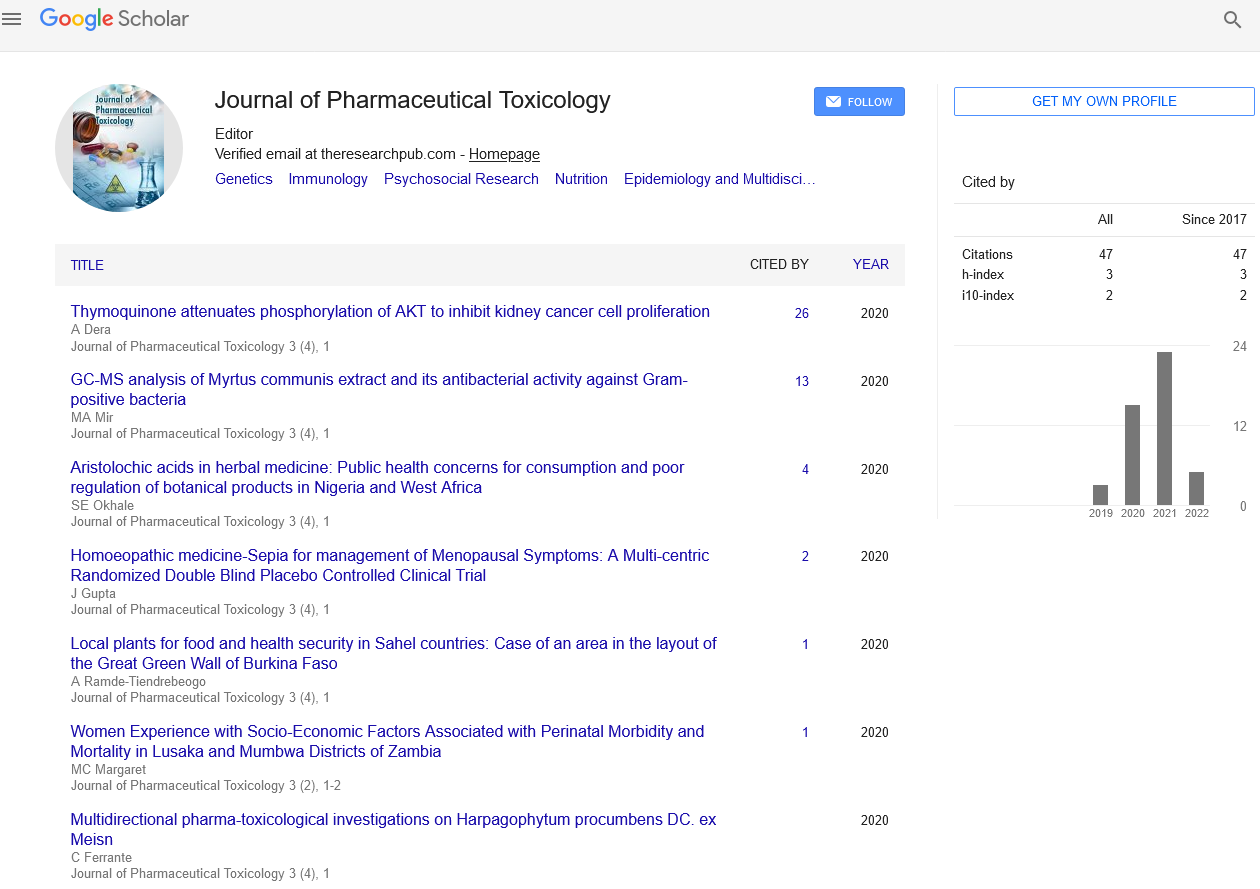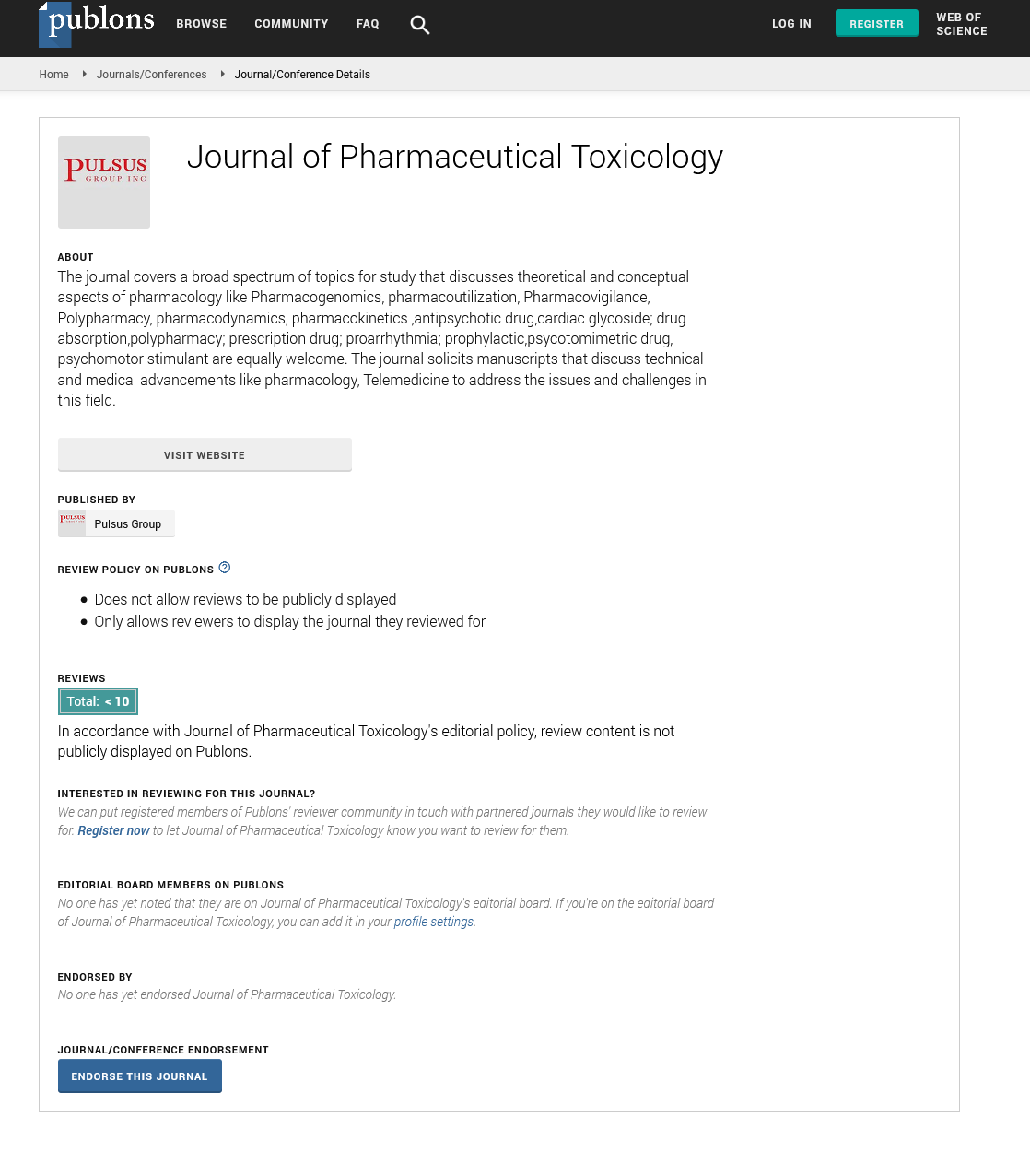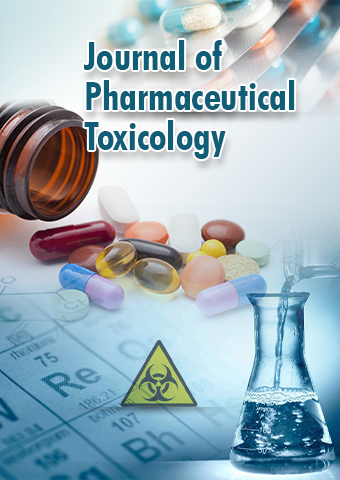Research Article - Journal of Pharmaceutical Toxicology (2023) Volume 6, Issue 2
The Importance of Pharmaceutical Toxicology in Drug Development
Maanvi Gupta*
Rofel Shri G M Bilakhia College of Pharmacy, Gujarat Technological University, India
Rofel Shri G M Bilakhia College of Pharmacy, Gujarat Technological University, India
E-mail: maanvigupta22@gmail.com
Received: 03-April-2023, Manuscript No. jpt-23-94551; Editor assigned: 5-April-2023, PreQC No. jpt-23-94551 (PQ); Reviewed: 19-April-2023, QC No. jpt-23-94551; Revised: 21-April-2023, Manuscript No. jpt-23- 94551 (R); Published: 28-April-2023, DOI: 10.37532/jpt.2023.6(2).29-32
Abstract
Abstract Pharmaceutical toxicology plays a critical role in drug development by assessing the safety of new drugs before they can be approved for use in humans. The goal of pharmaceutical toxicology is to identify any potential adverse effects of a drug, determine their severity, and establish the safe dosage range for human use. This article will explore the importance of pharmaceutical toxicology in drug development and the various methods used in toxicology testing. Pharmaceutical toxicology is essential in drug development because it ensures that drugs are safe for human use. Many drugs have the potential to cause adverse effects, ranging from mild to life-threatening. These effects may not be apparent during early stages of drug development or in animal studies, but can be observed in humans. Therefore, it is important to conduct comprehensive safety studies on new drugs to ensure their safety and effectiveness.
Keywords
Mucilage • Pharmaceutical excipients • Tablets • physicochemical characterization
Introduction
Pharmaceutical toxicology involves a series of tests and evaluations to assess the safety of a drug. These tests are conducted in vitro (in the laboratory) and in vivo (in living organisms). In vitro tests are conducted on isolated cells or tissues to determine the potential toxicity of a drug. In vivo tests are conducted on animals to assess the safety of a drug before it is tested on humans [1]. The first step in pharmaceutical toxicology is to determine the toxic dose of a drug, which is the amount of the drug that causes toxicity in test subjects. This is determined by administering various doses of the drug to test subjects and monitoring their responses. The results of these tests are used to establish a safe dosage range for human use.
Pharmaceutical toxicology also involves evaluating the potential adverse effects of a drug on various organs and systems in the body. This includes assessing the effects of a drug on the liver, kidneys, cardiovascular system, and nervous system, among others. These evaluations are conducted using a variety of tests, including histopathology, biochemistry, and pharmacology. Histopathology involves examining tissue samples from test subjects to detect any abnormalities or damage. Biochemistry involves analyzing blood and urine samples to detect any changes in organ function or metabolism. Pharmacology involves studying the effects of a drug on various physiological and biochemical processes in the body [2].
Nonclinical safety testing is an essential component of pharmaceutical toxicology. Nonclinical safety testing involves evaluating the safety of a drug in animals before it is tested in humans. The goal of nonclinical safety testing is to identify any potential adverse effects of a drug and establish a safe dosage range for human use. Nonclinical safety testing involves a series of tests, including acute toxicity testing, sub chronic toxicity testing, and chronic toxicity testing. Acute toxicity testing involves administering a single high dose of a drug to test subjects to assess its potential toxicity. Sub chronic toxicity testing involves administering the drug to test subjects for a period of up to three months to assess its potential toxicity over an extended period. Chronic toxicity testing involves administering the drug to test subjects for a period of more than three months to assess its potential toxicity over a long-term period. Nonclinical safety testing is important because it helps to establish the safety of a drug before it is tested in humans. This ensures that any potential adverse effects of the drug are identified and addressed before it is approved for human use [3].
Regulatory authorities play a critical role in pharmaceutical toxicology by ensuring that drugs are safe for human use. Regulatory authorities require that all drugs undergo comprehensive safety testing before they can be approved for use in humans. This includes nonclinical safety testing and clinical trials. Regulatory authorities also require that all drugs undergo postmarketing surveillance to monitor their safety and effectiveness. Pharmaceutical toxicology is a branch of toxicology that deals with the study of the adverse effects of drugs and other pharmaceutical products on biological systems. The main aim of pharmaceutical toxicology is to ensure that the medications and drugs that are developed and marketed are safe and effective for use by humans [4]. Over the years, pharmaceutical toxicology has played a crucial role in drug development, testing, and regulation, leading to the development of effective and safe medications. This article will discuss the current trends and future directions in pharmaceutical toxicology, and how it has contributed to ensuring safe and effective medications.
Discussion
The pharmaceutical industry has been leveraging new technologies such as artificial intelligence (AI), machine learning (ML), and highthroughput screening (HTS) to enhance drug development and safety assessment. These technologies enable the identification of potential toxicities at earlier stages of drug development, leading to more efficient drug development processes and increased safety of medications. Traditionally, the safety and efficacy of drugs have been tested using animal models [5]. However, the use of animal models has limitations, such as ethical concerns and the inability to fully mimic human physiology. Thus, there has been a shift towards using alternative testing methods, such as in vitro assays and computer modeling. These methods allow for a more accurate prediction of drug safety and efficacy in humans.
Personalized medicine is an approach that considers an individual’s unique genetic makeup, environment, and lifestyle when designing treatment plans. Pharmaceutical toxicology plays a crucial role in personalized medicine by identifying genetic biomarkers that can predict drug toxicity and efficacy. By considering an individual’s genetic makeup, pharmaceutical toxicology can ensure that the medications prescribed are safe and effective for each patient [6].
The increasing availability of big data in healthcare provides an opportunity for pharmaceutical toxicology to leverage this data to improve drug development and safety assessment. By analyzing large datasets, pharmaceutical toxicology can identify patterns and associations between drug exposure and adverse effects. This can lead to the identification of new drug targets and the development of safer and more effective medications. Precision toxicology is an emerging field that aims to identify individual susceptibility to toxicities based on genetic and environmental factors. This approach can be used to identify patient populations that are more susceptible to adverse drug reactions and design personalized treatment plans for these patients. Organ-ona- chip technology is a promising alternative to animal testing, as it enables the testing of drugs on miniature human organs. This technology provides a more accurate representation of human physiology and can be used to assess drug safety and efficacy at an earlier stage of drug development [7].
Pharmaceutical toxicology plays a crucial role in ensuring safe and effective medications for humans. The current trends and future directions in pharmaceutical toxicology, such as the integration of new technologies, the use of alternative testing methods, and personalized medicine, will continue to enhance drug development and safety assessment. Additionally, emerging fields such as precision toxicology and organ-on-a-chip technology have the potential to revolutionize drug development and ensure that medications are safe and effective for all individuals. Pharmaceutical toxicology is a vital field of study that plays a crucial role in drug development and safety assessment. It involves the assessment of the potential risks associated with the use of pharmaceutical products, including their toxicological effects on human health and the environment. The process of drug development is complex and time-consuming, and the identification of toxicological hazards and risks associated with a new drug is an important aspect of the overall drug development process. This article will discuss the role of pharmaceutical toxicology in drug development and safety assessment, the challenges facing the field, and the opportunities for future research and development [8].
Pharmaceutical toxicology plays a critical role in drug development by identifying potential toxicological hazards and risks associated with a new drug. The primary goal of pharmaceutical toxicology is to ensure the safety of the drug for human use. This involves evaluating the pharmacological properties of the drug, its potential toxicity, and the potential for adverse reactions. Toxicologists use a range of approaches, including animal studies, in vitro assays, and computer modeling, to assess the toxicity of a new drug. One of the key benefits of pharmaceutical toxicology is that it can help to identify potential safety concerns early in the drug development process. This can help to reduce the risks associated with the drug and improve its overall safety profile. In addition, pharmaceutical toxicology can also help to identify potential drug interactions and inform the development of dosing guidelines. Despite the many benefits of pharmaceutical toxicology, the field also faces several challenges. One of the primary challenges is the need for more accurate and predictive models for assessing the toxicity of new drugs. Traditional animal models have limitations in terms of their predictive value, and there is a need for more advanced in vitro and computer-based models [9].
Another challenge facing pharmaceutical toxicology is the need for greater collaboration between different disciplines. The field of pharmaceutical toxicology requires expertise in a range of different areas, including pharmacology, toxicology, chemistry, and biology. Greater collaboration between experts in these areas can help to improve the accuracy and reliability of toxicity assessments. Finally, there is a need for greater transparency and communication in the field of pharmaceutical toxicology. The safety of pharmaceutical products is a critical issue, and there is a need for greater transparency and openness in the reporting of safety data. This can help to build trust and confidence in the safety of pharmaceutical products among both healthcare professionals and the general public [10].
Conclusion
Despite the challenges facing pharmaceutical toxicology, there are also many opportunities for future research and development. One area of potential research is the development of more accurate and predictive in vitro and computerbased models for assessing the toxicity of new drugs. Advances in technology, such as highthroughput screening and gene editing, may provide new opportunities for developing more advanced toxicity models.
Another area of potential research is the development of personalized medicine approaches that take into account individual differences in drug metabolism and toxicity. This could involve the use of biomarkers to identify individuals who may be at increased risk of adverse drug reactions, or the development of dosing guidelines based on individual patient characteristics. Finally, there is a need for greater emphasis on the environmental impact of pharmaceutical products. The disposal of pharmaceutical products can have a significant impact on the environment, and there is a need for more research on the potential ecological impacts of these products.
Conflict of Interest
None
Acknowledgement
None
References
- Cho NH, Shaw JE, Karuranga A. IDF Diabetes Atlas: global estimates of diabetes prevalence for 2017 and projections for 2045. J Diabetes Res. 138,271-281 (2018).
- Semenkovich K, Brown ME, Svrakic DM et al. Depression in type 2 diabetes mellitus: prevalence, impact, and treatment. Drugs. 75,577-587 (2015).
- Fradkin J. Diabetes clinical trials: what is new at NIDDK? Clin Diabetes. 22,109-112 (2004).
- Lu Z, Su J. Clinical data management: current status, challenges, and future directions from industry perspectives. Open Access J Clin Trials. 2,93-105 (2010).
- Nourani A, Ayatollahi H, Dodaran MS et al. Clinical trial data management software: a review of the technical features. Rev Recent Clin Trials. 14,160-172 (2019).
- Krishnankutty B, Naveen Kumar B, Moodahadu L et al. Data management in clinical research. Indian.33,122-126 (2010).
- Cavenaugh JS, Snell P, Jeffries D et al. A relational database for management of flow cytometry and ELISpot clinical trial data. Clinical Cytometry. 72,49-62 (2007).
- Das S, Zijdenbos AP, HarlapJ et al. A web-based data management system for multi-center studies. Front Neuroinform. 5,37-11 (2011).
- Gao QB, Kong Y, Fu Z et al. A clinical data management system. Comput Biol Med. 38,1042-1044 (2008).
- Ngari MM, Waithira N, Chilengi R et al. Experience of using an open source clinical trials data management software system in Kenya. BMC Research Notes. 7,845-853 (2014).
Google Scholar, Crossref, Indexed at
Google Scholar, Crossref, Indexed at
Google Scholar, Crossref, Indexed at
Google Scholar, Crossref, Indexed at
Google Scholar, Crossref, Indexed at
Google Scholar, Crossref, Indexed at
Google Scholar, Crossref, Indexed at
Google Scholar, Crossref, Indexed at


